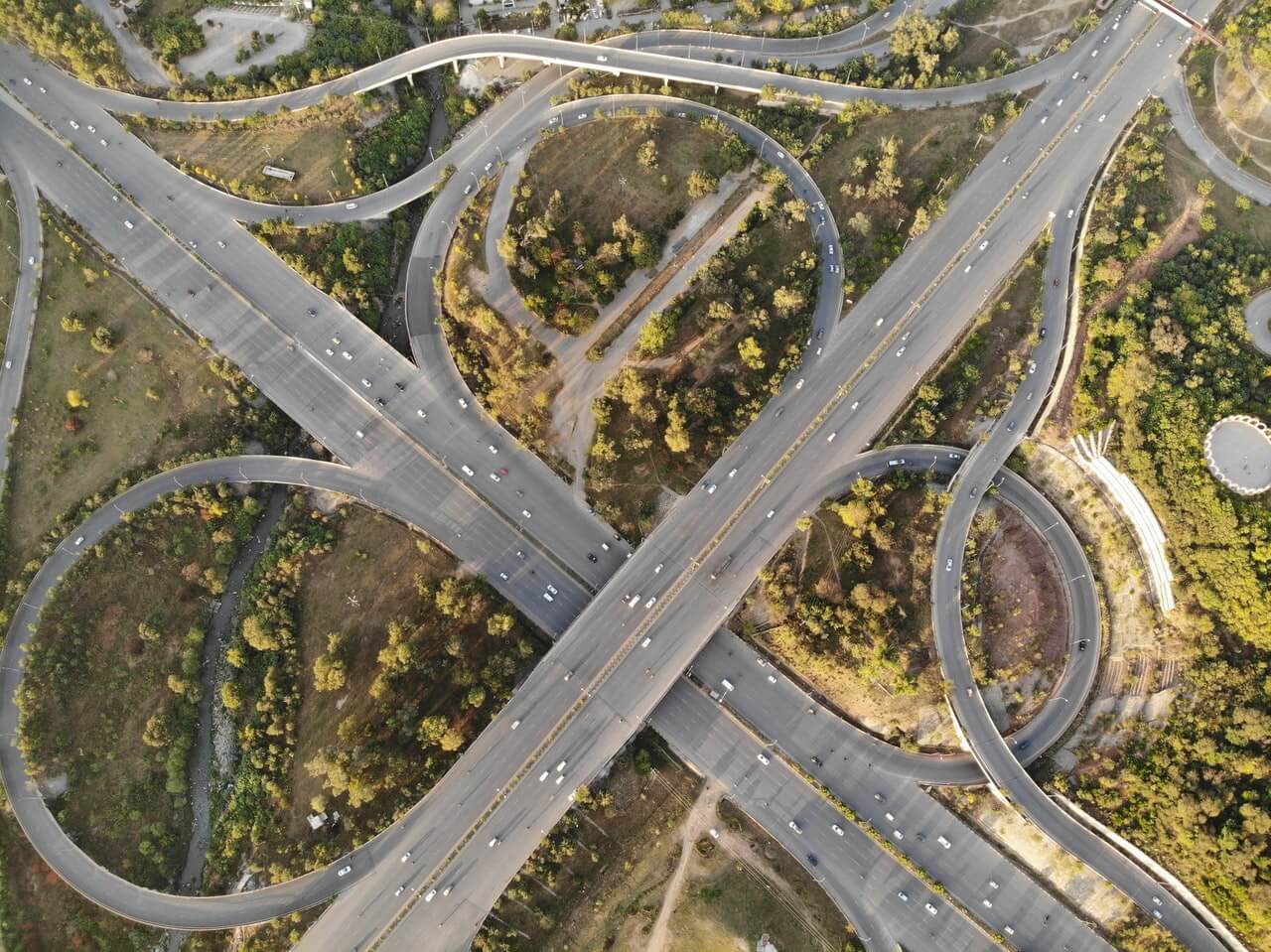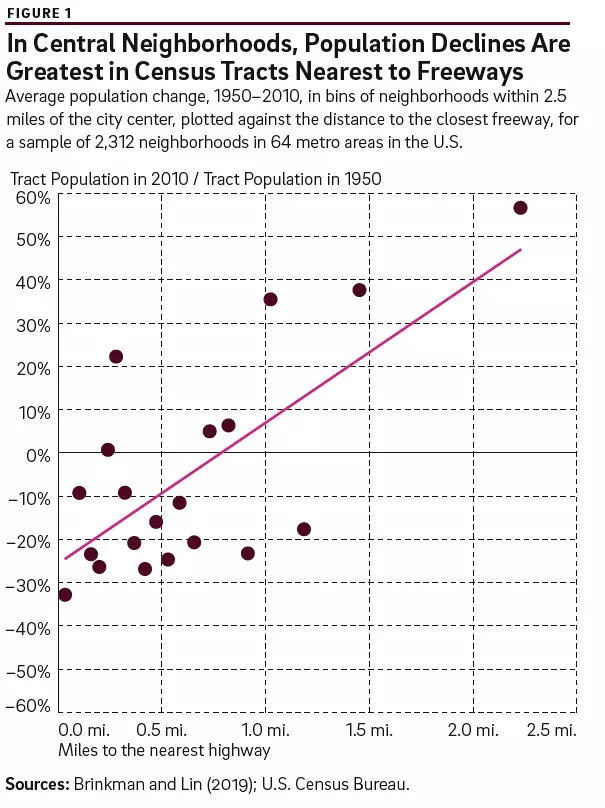Comments
- No comments found

Major freeways offer substantial economic benefits to an urban area or region.
If you doubt it, try to name a major US economic center that is disconnected from the interstate highway system. But major freeways are not a win-win for everyone within an urban area. Often, they are a win for the suburban residential areas that have better connections to central downtown business districts, and for the central business districts that have access to a wider pool of workers. However, freeways often represent a loss for residential areas within cities. These areas already had fairly easy access to downtown, so they benefit little from the additional freeway access; indeed, the addition of freeways can make it harder for them to get downtown. Living beside a major highway is widely viewed as a negative. Moreover, major highways divide up and segment urban neighborhoods, in a way that makes walking, driving, or shopping more difficult, and in some cases will cut neighborhoods off from amenities like parks or access to waterfront.
Some cities are wondering if new construction projects might mitigate some of these costs. Boston’s “Big Dig” project, as one example, took the main highway running through downtown, buried it in a 1.5-mile long tunnel, and put a “greenway” through the city on top. In San Francisco, after the Loma Prieta earthquake in 1989 damaged the Embarcadaro freeway that had cut across the city, a decision was made to eliminate that freeway rather than rebuilding it. Dallas built a public park over the top of a freeway in 2012. In Atlanta, Philadelphia, and my own metro area of Minneapolis-St. Paul, there are speculative proposals about whether it might be worth putting a “lid” over a major freeway in a way that would reconnect neighborhoods and provide space for additional housing.
Jeffrey Brinkman and Jeffrey Lin of the Philadelphia Fed discuss the issues in “The Costs and Benefits of Fixing Downtown Freeways,” subtitled “Urban freeways spurred our suburban boom. Can burying them do the same for the urban core?” (Economic Insights, Winter 2022, 7:1, pp. 17-22). They write:
Using fine geographic data covering 1950 to 2010, we studied long-run changes in neighborhoods before and after the interstate highway system was built (Figure 1). We find that in the group of central- city neighborhoods closest to freeways, population declined by 32 percent, while in the group of central neighborhoods more than 2 miles from freeways, population actually grew by 56 percent.

Of course, estimates of costs and benefits of this kind of project need to be taken with a dose of skepticism, but in rough numbers, it looks like this. The costs of these freeway-capping projects seem to vary from $300 million to $700 million per mile. Take a mid-range value of $500 million per mile, and capping the 4.5-mile stretch would cost $2.25 billion. Their simulations suggest that the project would dramatically increase population density and land values in the area: “The first result of the experiment is that population near the freeway increases drastically, with population densities of employed individuals in neighborhoods near the freeway increasing by as much as 2,840 people per square mile after the intervention. Overall, for neighborhoods within one mile of the freeway project, population increases by 7 percent in this scenario. Land prices in these same neighborhoods increase by 2.4 percent.” They estimate the total benefits at $3.5 billion.To explore the potential costs and benefits of capping a stretch of freeway, Brinkman and Lin consider a large-scale project that would involve burying a 4.5-mile stretch of I-95, a major freeway that runs through downtown Philadelphia. As they point out, when I-95 was built 60 years ago, the area along the Delaware River was a declining industrial zone. Now, it would be possible to reshape that area into a waterfront park–if it wasn’t effectively cut off from much of the downtown by the freeway.
There are of course all sorts of other issues here. Reasonable skeptics will note that if the costs of capping the freeway come in closer to $700 million per mile or above, the balance of gains over costs becomes much smaller. The results also turn on estimates of how much people would value the gain in amenities from living in neighborhoods not disrupted by a freeway and with easy access to a riverfront park. They write: “If we use values at the high end of existing estimates, the benefits of mitigation can increase by 100 percent, whereas low-parameter estimates can reduce the benefits by about 30 percent.” There’s also the practical question of who will pay for the project. The authors point out that since the benefits are concentrated in certain areas of Philadelphia, one can imagine that a substantial share of the costs would and should could be covered by a targeted property tax assessment.
It’s impossible to make some blanket statement about whether putting a lid over highways or burying them in tunnels will be worthwhile. But it’s not a crazy idea. In some cases, it may be well worth the costs–and a key to resuscitating urban neighborhoods have long suffered from their proximity to freeways.
Timothy Taylor is an American economist. He is managing editor of the Journal of Economic Perspectives, a quarterly academic journal produced at Macalester College and published by the American Economic Association. Taylor received his Bachelor of Arts degree from Haverford College and a master's degree in economics from Stanford University. At Stanford, he was winner of the award for excellent teaching in a large class (more than 30 students) given by the Associated Students of Stanford University. At Minnesota, he was named a Distinguished Lecturer by the Department of Economics and voted Teacher of the Year by the master's degree students at the Hubert H. Humphrey Institute of Public Affairs. Taylor has been a guest speaker for groups of teachers of high school economics, visiting diplomats from eastern Europe, talk-radio shows, and community groups. From 1989 to 1997, Professor Taylor wrote an economics opinion column for the San Jose Mercury-News. He has published multiple lectures on economics through The Teaching Company. With Rudolph Penner and Isabel Sawhill, he is co-author of Updating America's Social Contract (2000), whose first chapter provided an early radical centrist perspective, "An Agenda for the Radical Middle". Taylor is also the author of The Instant Economist: Everything You Need to Know About How the Economy Works, published by the Penguin Group in 2012. The fourth edition of Taylor's Principles of Economics textbook was published by Textbook Media in 2017.
Leave your comments
Post comment as a guest